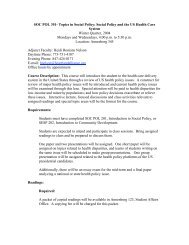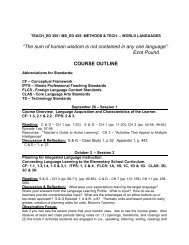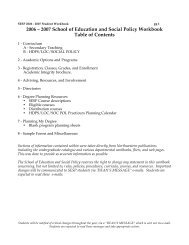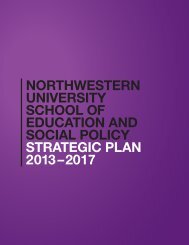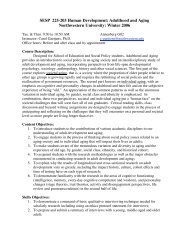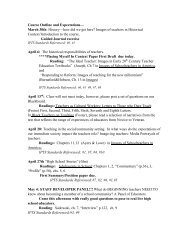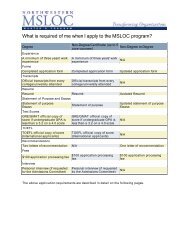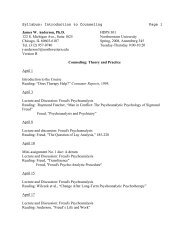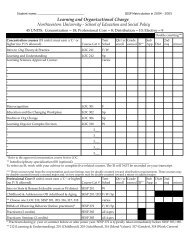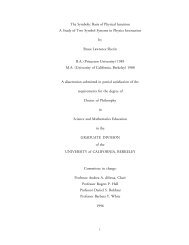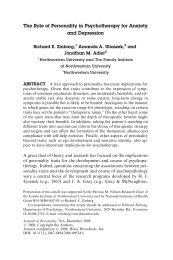Effects of Parental Marital Status, Income, and Family Functioning on ...
Effects of Parental Marital Status, Income, and Family Functioning on ...
Effects of Parental Marital Status, Income, and Family Functioning on ...
You also want an ePaper? Increase the reach of your titles
YUMPU automatically turns print PDFs into web optimized ePapers that Google loves.
476 MANDARA AND MURRAY<br />
<str<strong>on</strong>g>and</str<strong>on</strong>g> (c) the family functi<strong>on</strong>ing perspective<br />
(Amato & Keith, 1991; Heiss, 1996).<br />
<str<strong>on</strong>g>Family</str<strong>on</strong>g> Structure Perspective<br />
The historical method <str<strong>on</strong>g>of</str<strong>on</strong>g> studying African<br />
American youth focused <strong>on</strong> the pathological or<br />
disorganizati<strong>on</strong>al aspects <str<strong>on</strong>g>of</str<strong>on</strong>g> the family<br />
(Littlejohn-Blake & Darling, 1993). This focus<br />
led to the family structure perspective, which<br />
essentially states that two-parent homes facilitate<br />
a better envir<strong>on</strong>ment for youths' well-being<br />
compared with single-parent homes (Erel &<br />
Burman, 1995). This theory suggests that adolescents<br />
<str<strong>on</strong>g>and</str<strong>on</strong>g> children from single-parent homes<br />
are severely h<str<strong>on</strong>g>and</str<strong>on</strong>g>icapped. Accordingly, this<br />
perspective argues that all things being equal,<br />
the most salient effect <str<strong>on</strong>g>of</str<strong>on</strong>g> single-parent homes<br />
<strong>on</strong> children is the lack <str<strong>on</strong>g>of</str<strong>on</strong>g> the physical presence<br />
<str<strong>on</strong>g>of</str<strong>on</strong>g> two parents. Often the methodology employed<br />
either marital status or some other identifier<br />
<str<strong>on</strong>g>of</str<strong>on</strong>g> two parents in the home as the main<br />
independent variable for predicting outcomes<br />
(Florsheim, Tolan, & Gorman-Smith, 1998).<br />
Recent studies <str<strong>on</strong>g>of</str<strong>on</strong>g> African American populati<strong>on</strong>s<br />
indicated that children from two-parent<br />
homes do better than children from singleparent<br />
homes <strong>on</strong> a variety <str<strong>on</strong>g>of</str<strong>on</strong>g> social indicators<br />
(Coley, 1998; McLeod, Kruttschnitt, & Dornfeld,<br />
1994; Teachman, Day, Paasch, Carver, &<br />
Call, 1998). For instance, McLanahan (1985)<br />
found that African American children living<br />
with <strong>on</strong>e parent were less likely to be in school<br />
at age 17 than their two-parent counterparts. In<br />
another study, a significant positive relati<strong>on</strong>ship<br />
was found between father presence <str<strong>on</strong>g>and</str<strong>on</strong>g> selfesteem<br />
(Alst<strong>on</strong> & Williams, 1982). Fatherpresent<br />
youths also exhibited str<strong>on</strong>ger scholastic<br />
achievement <str<strong>on</strong>g>and</str<strong>on</strong>g> more stable peer relati<strong>on</strong>s.<br />
The researchers c<strong>on</strong>cluded that the father-s<strong>on</strong><br />
relati<strong>on</strong>ship facilitated the adopti<strong>on</strong> <str<strong>on</strong>g>of</str<strong>on</strong>g> an adequate<br />
self-c<strong>on</strong>cept because boys were able to<br />
model their fathers. Another recent study (Paschall,<br />
Ennett, & Flewelling, 1996) found that<br />
living in a single-parent home was a significant<br />
risk factor for violent behavior in African<br />
American children. Another study <str<strong>on</strong>g>of</str<strong>on</strong>g> 107 lowincome<br />
African American children found that<br />
children whose fathers were present had significantly<br />
higher adaptive functi<strong>on</strong>ing scores than<br />
did children whose fathers did not live with<br />
them (Dunn & Tucker, 1993). A recent l<strong>on</strong>gitudinal<br />
study found that African American children<br />
in two-parent homes had significantly<br />
higher math <str<strong>on</strong>g>and</str<strong>on</strong>g> reading scores <str<strong>on</strong>g>and</str<strong>on</strong>g> lower behavioral<br />
problems than did children in singleparent<br />
homes. The results held up over a 4-year<br />
period for both older <str<strong>on</strong>g>and</str<strong>on</strong>g> younger siblings in the<br />
sample (Teachman et al., 1998).<br />
However, some researchers highlighted the<br />
fact that not all studies show advantages for<br />
two-parent homes (Heiss, 1996; Phillips & Asbury,<br />
1993). Also, even for the studies that do,<br />
the effect sizes may not be large enough to be<br />
socially relevant (Heiss, 1996). Many researchers<br />
also argued that the c<strong>on</strong>sequences <str<strong>on</strong>g>of</str<strong>on</strong>g> singleparent<br />
homes were mainly related to the ec<strong>on</strong>omic<br />
deprivati<strong>on</strong> <str<strong>on</strong>g>of</str<strong>on</strong>g> the single-parent home<br />
(e.g., McLeod et al., 1994; A. N. Wils<strong>on</strong>, 1979),<br />
<str<strong>on</strong>g>and</str<strong>on</strong>g> others argued that the studies did not account<br />
for important aspects <str<strong>on</strong>g>of</str<strong>on</strong>g> family functi<strong>on</strong>ing<br />
or extended kin (Dancy & H<str<strong>on</strong>g>and</str<strong>on</strong>g>al, 1984;<br />
Logan, 1996; L<strong>on</strong>g, 1986; Partridge & Kotler,<br />
1987; Scott & Black, 1989). For instance,<br />
Boyd-Franklin (1989) argued that the strength<br />
<str<strong>on</strong>g>of</str<strong>on</strong>g> flexible family roles in African American<br />
families has not been taken into c<strong>on</strong>siderati<strong>on</strong>.<br />
In other words, many researchers have been<br />
interested in knowing whether the observed effects<br />
<str<strong>on</strong>g>of</str<strong>on</strong>g> family structure persisted when important<br />
sociodemographic <str<strong>on</strong>g>and</str<strong>on</strong>g> envir<strong>on</strong>mental variables,<br />
such as family income <str<strong>on</strong>g>and</str<strong>on</strong>g> family<br />
functi<strong>on</strong>ing were c<strong>on</strong>trolled (Demo & Acock,<br />
1988; Partridge & Kotler, 1987). These assumpti<strong>on</strong>s<br />
<str<strong>on</strong>g>and</str<strong>on</strong>g> questi<strong>on</strong>s led to alternative theoretical<br />
perspectives.<br />
<str<strong>on</strong>g>Family</str<strong>on</strong>g> <str<strong>on</strong>g>Income</str<strong>on</strong>g> Perspective<br />
The ec<strong>on</strong>omic deprivati<strong>on</strong> perspective has<br />
been given enormous attenti<strong>on</strong> by researchers <str<strong>on</strong>g>of</str<strong>on</strong>g><br />
African American family processes (reviewed<br />
in Taylor, Chatters, Tucker, & Lewis, 1990),<br />
specifically with regard to single-mother homes<br />
(McLanahan, 1985; Wils<strong>on</strong>, 1979). Fifty percent<br />
<str<strong>on</strong>g>of</str<strong>on</strong>g> African American female-headed families<br />
live below the poverty line, which makes<br />
them the most impoverished group in America<br />
(Taylor et al., 1990).<br />
The prop<strong>on</strong>ents <str<strong>on</strong>g>of</str<strong>on</strong>g> the ec<strong>on</strong>omic deprivati<strong>on</strong><br />
perspective argued that the potential effects <str<strong>on</strong>g>of</str<strong>on</strong>g><br />
single parents is not due to the physical absence<br />
<str<strong>on</strong>g>of</str<strong>on</strong>g> <strong>on</strong>e parent but to the absence <str<strong>on</strong>g>of</str<strong>on</strong>g> the ec<strong>on</strong>omic<br />
resources generated by the absent parent. Therefore,<br />
the effects <str<strong>on</strong>g>of</str<strong>on</strong>g> marital status <strong>on</strong> child wellbeing<br />
will be reduced when income is statistically<br />
c<strong>on</strong>trolled or when families are matched<br />
<strong>on</strong> income level. For instance, McLeod et al.




